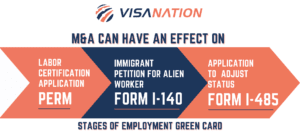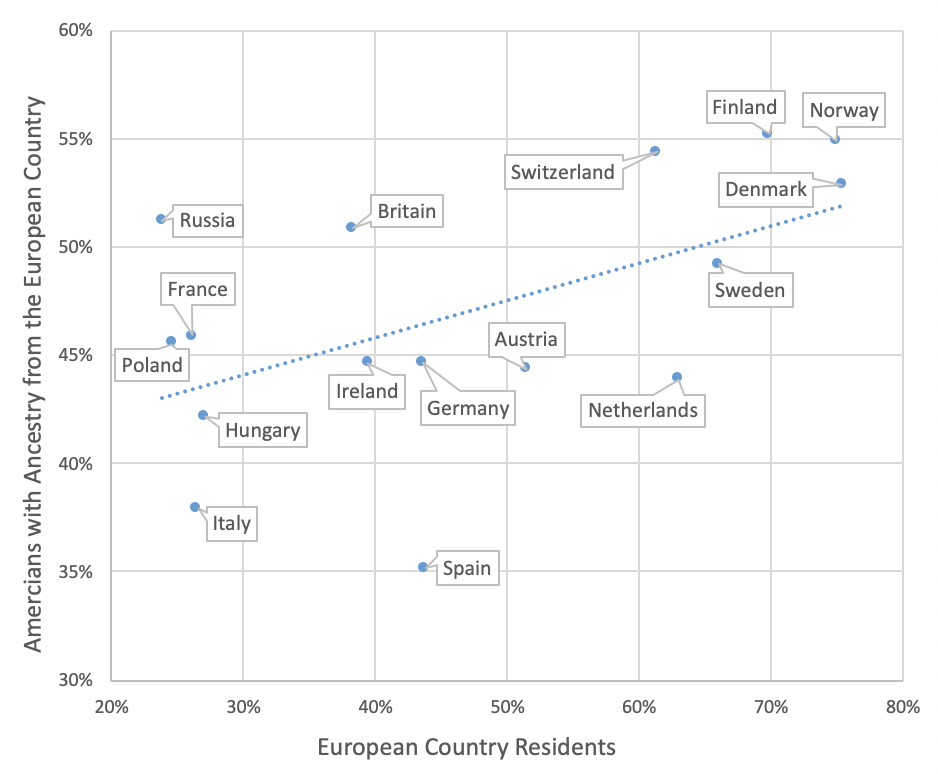How a Company Merger/Acquisitions Impacts Green Card & I-140
As individuals in business know, acquisitions, mergers, and other significant financial dealings can substantially affect aspects of a company. These matters can even disrupt the validity of a PERM labor certification that is pending or approved for a foreign national unless the new company also acquired the associated interests associated with the original LC application.
In this post, we’ll explore how a merger or acquisition typically impacts a PERM green card and I-140. Mind you, the process may vary on a case-by-case basis, and it’s advised to seek help from legal counsel before taking any immediate action.
Green Card Application During Merger or Acquisition
There are two factors that will determine the state of a pending green card application during a merger: acquisition or any type of corporate change. The first thing is the ability of the successor company to meet “successor in interest” requirements. The second factor is the stage of the green card application when corporate changes take place.
Determining Successor-in-Interest
Successor in interest simply means the new entity is ready to assume all the obligations and interests of the predecessor (the former owner). The obligations of the successor generally refer to the new entity’s eligibility and readiness to assume substantially all of the predecessor’s liabilities and assets, including all responsibilities related to the immigration sponsorship of the workers involved. The new owner must demonstrate the readiness and ability to continue employing workers in the same positions held with the predecessor.
For example, with an H-1B merger, the new entity must be ready to allow the worker to continue to perform the same job duties and function in the same Metropolitan Statistical Area (MSA). If this is the case, there will be no need for an amended H-1B petition or a new LCA. Below is the amended H-1B statute that addresses such change:
“An amended H-1B petition shall not be required where the petitioning employer is involved in a corporate restructuring, including but not limited to a merger, acquisition, or consolidation, where a new corporate entity succeeds to the interests and obligations of the original petitioning employer and where the terms of the employment remain the same but for the identity of the petitioner.”
Stages for Green Card Merger or Acquisition
Most employment-based green card categories have three application stages, which are the PERM labor certification application, filing Form I-140, Immigrant Petition for Alien Worker, and filing the I-485, Application to Register Permanent Residence or Adjust Status. The impact of a merger or acquisition during each of these three stages is explained below:
Company Merger and PERM Application
When a merger or acquisition occurs, a PERM labor certification application might continue to remain valid assuming that the new company is deemed the successor in any or all interests that the original company possessed, including filed PERM applications. In many scenarios, the new (or merged) company will take over all the assets of the original company, including intellectual rights, accounts receivable, contract rights, so on and so forth. In addition to the assets, it will typically also take on liabilities like obligations/ debts, accounts payable, etc. If that’s the case, the merged company will be the successor of the interests owned by the original company, and they may choose to continue the filing of the PERM process for foreign nationals.
What Happens Before PERM is Filed?
Often, a merger may take place prior to a PERM case getting formally filed and/or approved. When that happens, then the petitioner will need to demonstrate that the merged company is the successor of the interest that the original company filed. The first thing will be for the successor to review the pre-filing PERM steps—such as the recruitment process—and determine whether it was done reliably to continue the application process.
If there have been some changes since recruitment, the successor entity may need to restart the recruitment process. The essence is to ensure due diligence and avoid issuance of RFEs and delays from the DOL. The PERM application will need to be proven with substantial evidence in the event of an audit conducted by the Department of Labor. Therefore, a careful review will help address any loophole at the initial stage.
Another very important point is that the advertisements must be run by the employer at the moment of the recruiting period. Likewise, the ETA Form 9089 should reflect the employer at the moment of filing. In other words, if the acquisition and/or merger occurs prior to the PERM filing there cannot be any type of discrepancies between the employer’s name on the advertisements and name given on the PERM green card application.
Case Example of Merger on PERM Green Card
In this green card company merger example, we’ll use Company X and Company Y to illustrate the impact of a merger or acquisition on a PERM, PERM Green Card & I-140. Say Company X begins the recruitment period for a PERM employment position. For all the advertisements (required as part of the PERM process) the employer is noted as “Company X.” After the advertising recruitment period has ended, (but prior to the ETA Form 9089 getting filed) Company X gets acquired by Company Y.
Now, the ETA Form is getting filed, except the company that’s listed is labeled Company Y since Company X no longer exists as a result of the acquisition. In this scenario, Company Y needs to be ready to prove that it is the successor in any or all interests of Company X if for whatever reason they are audited. Due to the complexity of this case, an audit will most likely occur, so it’s crucial to be prepared with the proper documents.
When the Merger Occurs AFTER the PERM Submission
Not all mergers or acquisitions will occur before the PERM petition is submitted. In many cases, it may happen after the PERM petition and ETA Form 9089 are submitted (meaning the employers’ names will be the same on both). When this situation arises, the employer acquiring the old company should still be ready and prepared to demonstrate that they’re the successor in all interests possessed by the original company.
If the “successor-in-interest” requirements are met, then the new entity can rely on the pending PERM application to continue the green card sponsorship for the employee. If you have more questions related to a green card after the merger, it’s advised to contact a VisaNation Law Group PERM immigration lawyer for more information.
Company Merger During I-140 Petition
If an acquisition or merger occurs after the Form I-140 is filed and there have been no changes in a legal entity, then there would be no need to take any action regarding the already-filed Form I-140. However, if the corporate change occurs after filing the I-140 petition and results in a change of legal entity, the succeeding company may leverage the successor in interest eligibility to file an amended Form I-140 petition.
If the successor in interest eligibility requirements are met by the succeeding entity, then the foreign employee will be able to retain his or her original priority date without having to file a new I-140 petition. In relation to the I-140 petition, there are three factors required to establish eligibility for successor-in-interest:
- The job opportunity offered by the successor company must be the same as the job opportunity offered on the labor application certification.
- The successor company bears the burden of proof to establish eligibility in all respects. This includes the provision of required evidence from the predecessor company, such as evidence of the predecessor’s financial ability to pay the prevailing wage as of the date of filing the labor certification with DOL.
- The petitioner must fully document and describe the transfer and assumption of the ownership of the predecessor by the successor.
Documents to Establish Successorship
There are a number of documents that may be used to establish Company Y as a successor in the merger or acquisition. Documents include (but are not limited to):
- An official contract of sale of the acquisition
- Closing mortgage documents
- A Security Exchange Commission (SEC) Form 10-K
- Audited financial statements from the original company and the following year when the new company took over
- Any documents related to the transfer of property or business licenses
- Reports or articles announcing the acquisition or merger
In any or all cases, the new company must be able to demonstrate that they are the success in interest and that the other requirements have been met by the Department of Labor. USCIS still requires supporting evidence when filing an I-140.
USCIS did not always require these procedures to take place, however. In the past, it was policy only to accept approved Labor Certifications based on a successor in interest if the acquisition/merger happened after the PERM was approved. Luckily this is not the case anymore, and an LC based on a successor in interest can be filed at any point during the PERM process assuming the employer can prove they legitimately acquired the successor company and their assets/ liabilities.
What If the Successor in Interest Requirements Are Not Met?
If the successor company is unable to meet the successor in interest requirements, this can change the cause of the pending green card application in various ways. Due to the uniqueness of each case, the best thing is to contact an immigration attorney to know the next line of action regarding your case.
Merger During I-485 Petition
A merger or acquisition at this stage of a green card application can be the safest because there will be fewer steps for both the foreign worker beneficiary and the successor company to fulfill. This will, however, depend on how long the AOS petition has been pending with USCIS.
If the I-485 petition has been pending for 180 days or more, the adjustment of status application will become “portable,” which means the beneficiary can choose to work for any employer as long as the job offer matches his or her green card case. In light of this, the new employer may only need to prove that the role or job duties are in the same occupation that matches the underlying green card application.
I-9 Compliance During Corporate Changes
Form I-9 is used to verify the identity and employment authorization of people hired for employment in the U.S. This is to prevent those who are not eligible from taking up employment positions. In merger or acquisition, there are two options for successor companies when it comes to I-9 verification.
- They can require all the employees to complete new Form I-9s each.
- They can choose to take over the existing I-9s from the predecessor. In this case, they will assume all risks and liabilities associated with the existing I-9s.
The best thing is for the successor company to perform an I-9 audit before the completion of the acquisition or merger. This will help to determine which of the two options makes the most sense for the company.






